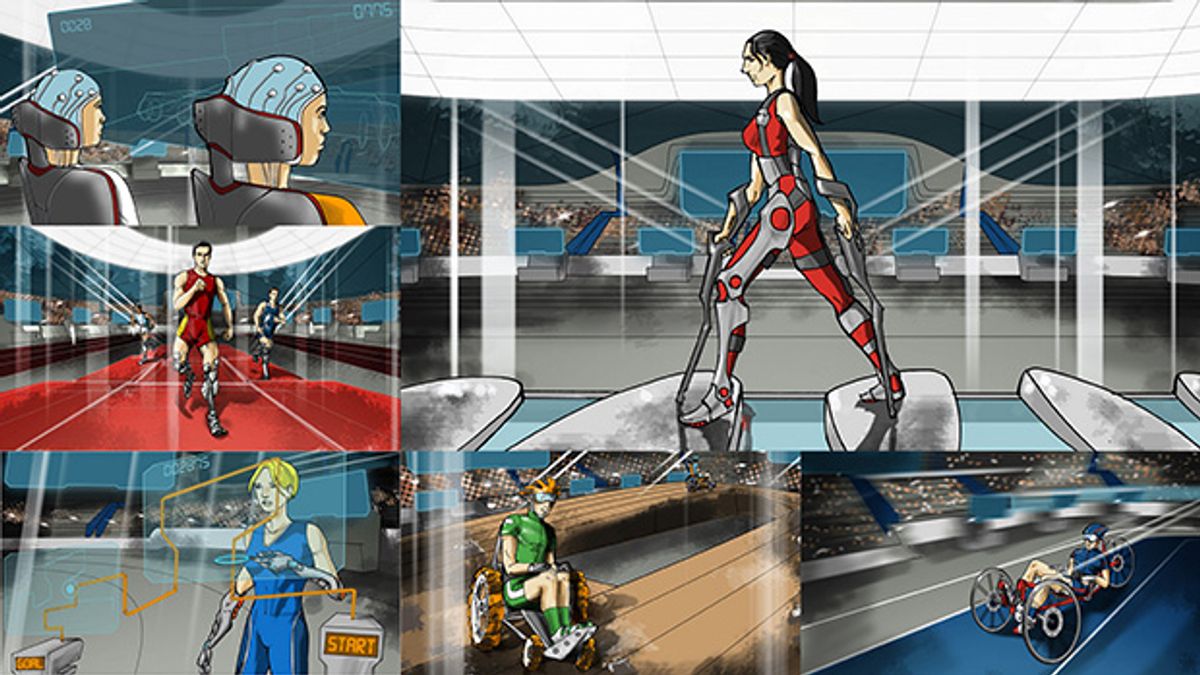The Olympic Games are a competition for the fittest and most talented able-bodied humans on Earth. The Paralympic Games are a competition for the fittest and most talented humans on Earth with physical and intellectual disabilities. To compete, paralympians take advantage of assistive systems, some of which are becoming increasingly cybernetic, combining traditional prosthetics with robotics. ETH Zurich and the Swiss National Competence Center of Research in Robotics have an idea of where we can take this.
It’s already the case that the Olympics are heavily influenced by technology. Aside from the 2012 controversy over whether paralympic sprinter Oscar Pistorius had an advantage in his carbon-fiber prosthetic legs, there are continual incremental advances in drag-reducing suits for swimmers and runners. Any event which requires hardware (shooting, archery, cycling, and so forth) is only going to become more heavily skewed towards tech, as human performance improvements will inevitably be eclipsed by technology, simply because it’s a lot easier to improve technology than it is to improve humans.
The athletes who have benefited the most from technology are arguably paralympians, who have a significantly heavier dependence on tech, and therefore more to gain as tech improves. Things like prosthetics are transitioning from passive systems to active ones, capable of sensing a user’s intent (through nerve or brain interfaces) and use motors and actuators to more effectively replace a real limb. The goal right now is to be able to provide capabilities similar to that of a human limb, but eventually, we’ll transcend biology, which is part of the reason why we need an entirely new type of competition.
The Cybathlon is a championship for racing pilots with disabilities (i.e. parathletes) who are using advanced assistive devices including robotic technologies. The competitions are comprised by different disciplines that apply the most modern powered knee prostheses, wearable arm prostheses, powered exoskeletons, powered wheelchairs, electrically stimulated muscles and novel brain-computer interfaces. The assistive devices can include commercially available products provided by companies, but also prototypes developed by research labs. There will be two medals for each competition, one for the pilot, who is driving the device, and one for the provider of the device. The event is organized on behalf of the Swiss National Competence Center of Research in Robotics (NCCR Robotics).
Here are the competitions:
Powered Arm Prosthetics Competition
Pilots with forearm or upper arm amputations will be equipped with actuated exoprosthetic devices and will have to successfully complete two hand-arm task courses as quickly as possible.
Brain-Computer Interface Race
Pilots will be equipped with brain-computer interfaces (BCIs) that will enable them to control an avatar in a racing game played on computers.
Functional Electrical Stimulation Bike Race
Pilots with complete Spinal Cord Injuries (SCI) will be equipped with Functional Electrical Stimulation (FES) devices, which will enable them to perform a pedaling movement on a cycling device that drives them on a circular course.
Powered Leg Prosthetics Race
Pilots with transfemoral amputation will be equipped with actuated exoprosthetic devices and will have to successfully complete a race course as quickly as possible.
Powered Exoskeleton Race
Pilots with complete thoracic or lumbar Spinal Cord Injuries (SCI) will be equipped with actuated exoskeletal devices, which will enable them to walk along a particular race course.
Powered Wheelchair Race
Pilots with different disability levels (e.g. quadriplegics, paraplegics, amputees) will be equipped with power wheelchairs, which will enable them to steer along a particular race course. The course will be defined by cones between which the pilots will have to maneuver the chair both forward and backward. In addition, obstacles of different sizes will be used.
There are many more details on each event at the Cybathalon website.
At some point, and it may be soon, paralympic athletes using robotic systems will be able to match, and then almost immediately surpass, unaugmented human athletes. Take the very first wire loop task, for example. The rules don’t (at least at this point) say anything about sensors. Conceivably, you could set up your prosthetic arm to make it impossible (or at least, very difficult) for the user to screw up, with the arm actively preventing any motion that would result in a penalty. Extending this to a mildly absurd but not entirely unrealistic endpoint, with a good enough combination of sensors and actuators, the human user could just grab onto the conductive wire loop and walk down the course, relying on their arm to autonomously perform all of the necessary movements.
The question, then, starts to become one of how much of an athlete is human, and how much of an athlete is robot, and if you’ve got more robot than human going on, how will that change things? We’ll find out on October 8, 2016, when the first Cybathalon event is held in Zurich, Switzerland.
[ Cybathalon ]
Thanks Markus!
Evan Ackerman is a senior editor at IEEE Spectrum. Since 2007, he has written over 6,000 articles on robotics and technology. He has a degree in Martian geology and is excellent at playing bagpipes.









